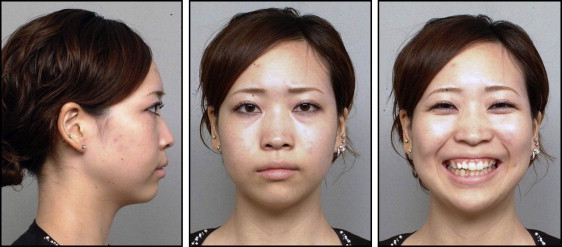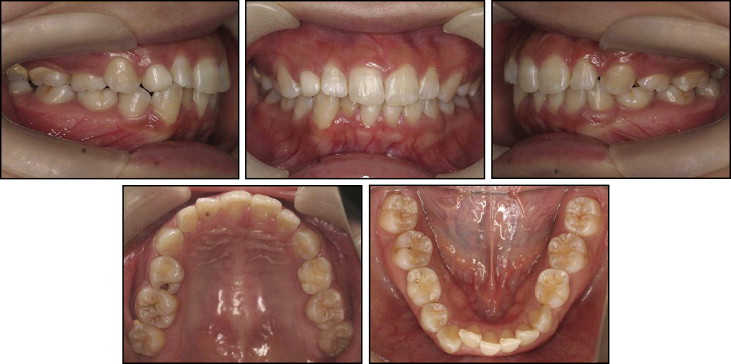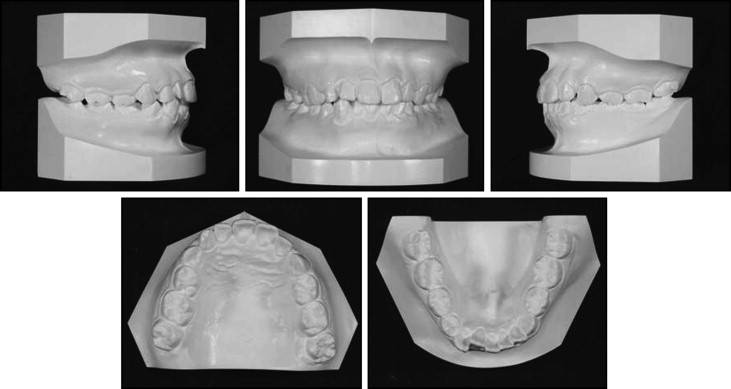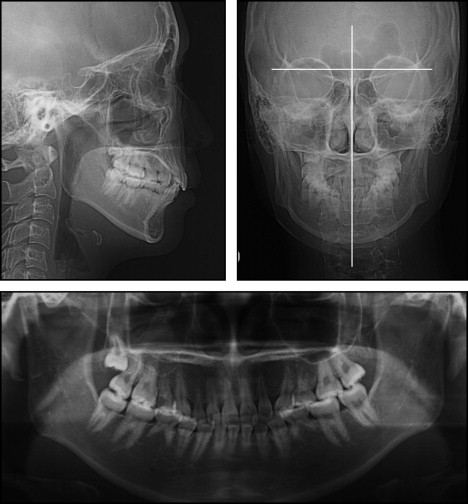This report describes the treatment of a 20-year-old woman with a dental midline deviation and 7 congenitally missing premolars. She had retained a maxillary right deciduous canine and 4 deciduous second molars, and she had an impacted maxillary right third molar. The maxillary right deciduous second molar was extracted, and the space was nearly closed by mesial movement of the maxillary right molars using an edgewise appliance and a miniscrew for absolute anchorage. The miniscrew was removed, and the extraction space of the maxillary right deciduous canine was closed, correcting the dental midline deviation. After the mesial movement of the maxillary right molars, the impacted right third molar was aligned. To prevent root resorption, the retained left deciduous second molars were not aligned by the edgewise appliance. The occlusal contact area and the maximum occlusal force increased over the 2 years of retention. The miniscrew was useful for absolute anchorage for unilateral mesial movement of the maxillary molars and for the creation of eruption space and alignment of the impacted third molar in a patient with oligodontia.
Oligodontia is the rare congenital absence of more than 6 permanent teeth, excluding the third molars. The spaces created as a result of congenitally missing permanent teeth are often corrected using prosthetic appliances, tooth transplantations, or orthodontic treatment. However, orthodontic treatment can be difficult in patients with oligodontia if the required distance for tooth movement is large and few teeth are available for anchorage.
Recently, miniscrews have been used for absolute anchorage in various types of procedures involving tooth movement. In a patient with skeletal Class III and oligodontia, miniscrews and anchorage wires were used in the retromolar area for mesial movement of the mandibular molars. In another patient with skeletal Class III, miniscrews were used to close the unilateral maxillary extraction spaces of the molars. However, there have been few case reports in which miniscrews were used for absolute anchorage to move molars mesially. Additionally, to our knowledge, there have been no case reports describing the use of miniscrews in the mesial movement of molars for alignment of an impacted third molar in a patient with a skeletal Class II relationship and oligodontia. This case report demonstrates successful treatment with miniscrews to enable unilateral mesial movement of the maxillary molars in a patient with oligodontia.
Diagnosis and etiology
The patient was a 20-year-old woman with the chief complaint of maxillary and mandibular dental midline deviations to the left and crowded mandibular anterior teeth. Her facial profile was mildly convex, and she had a mildly gummy smile ( Fig 1 ). She had a 5.0-mm overjet and a 4.0-mm overbite with a 1.5-mm mandibular arch length discrepancy. An asymmetrical relationship between the canine and the first molar, and dental midline deviations from the facial midline were observed. These abnormalities were due to oligodontia; 7 premolars were congenitally missing, and she had a maxillary right deciduous canine and 4 deciduous second molars. The right canines had Class III occlusion, and the right first molar had Class II occlusion. Both left canines and first molars showed Class I relationships ( Figs 2 and 3 ). The panoramic radiograph indicated no root resorption in the deciduous molars, and the maxillary right third molar was impacted. Dental caries was noted in the maxillary right deciduous second molar ( Figs 2 and 4 ).




Lateral cephalometric analysis indicated a skeletal Class II jaw-base relationship with an ANB angle of 6.5° and an average mandibular plane angle of 32.0°. The lingual inclination of the maxillary central incisor to the Frankfort plane angle was slightly small (104.5°). The relationship of the mandibular central incisors to the Frankfort plane angle (52.0°) was normal ( Fig 4 , Table I ). The frontal cephalometric analysis showed that the mandible was not deviated, but the maxillary and mandibular dental midlines had deviated by 3.0 mm to the left of the facial midline ( Fig 4 ).
| Measurement | Norm | Pretreatment | Posttreatment | |
|---|---|---|---|---|
| Mean or range | SD | (20 y 9 mo) | (24 y 9 mo) | |
| Angular (°) | ||||
| SNA | 82.3 | 3.5 | 85.0 | 85.0 |
| SNB | 78.9 | 3.5 | 78.5 | 78.0 |
| ANB | 3.4 | 1.8 | 6.5 | 7.0 |
| MP angle | 28.8 | 5.2 | 32.0 | 32.5 |
| IMPA | 96.3 | 5.8 | 96.0 | 92.0 |
| U1-FH | 111.1 | 5.5 | 104.5 | 101.0 |
| L1-FH | 54.6 | 6.5 | 52.0 | 55.5 |
| Linear (mm) | ||||
| U1 to APo | 7.1 | 2.2 | 8.0 | 4.0 |
| L1 to APo | 3.6 | 2.8 | 3.0 | 1.5 |
| Upper lip–E-line | −1 to −4 | – | +0.7 | −1.0 |
| Lower lip–E-line | 0 to +2 | – | +3.0 | 0 |
The maximum occlusal force and the occlusal contact area were examined using an occlusal force recording system (Dental Prescale & Occluzer; Fuji Film, Tokyo, Japan) and were found to be normal compared with those in normal subjects ( Table II ).
| Pretreatment | Posttreatment | Retention | Normative value ∗ | |
|---|---|---|---|---|
| Maximum occlusal force (N) | 872.4 | 690.0 | 1163.7 | 850.0 ± 231.9 |
| Occlusal contact area (mm 2 ) | 24.9 | 11.9 | 25.1 | 19.6 ± 6.6 |
This patient was diagnosed as having a malocclusion with oligodontia, maxillary and mandibular dental midline deviations, mandibular anterior crowding, an impacted maxillary right third molar, a mildly gummy smile, and a skeletal Class II jaw-base relationship.
Treatment objectives
Treatment was planned as follows: (1) extraction of the maxillary and mandibular right deciduous second molars; (2) mesial movement of the maxillary molars with a miniscrew, mesial movement of the mandibular molars, distal movement of the mandibular right first premolar, and retraction of the mandibular canine with preadjusted edgewise appliances on the right side ( Fig 5 , A ); (3) space closure to improve the mandibular midline deviation; (4) bite opening after extraction of the maxillary right deciduous canine; (5) space closure to improve the maxillary midline deviation and mesial movement of the maxillary molars after removing the miniscrew ( Fig 5 , B ); (6) marsupialization and alignment of the impacted maxillary right third molar; and (7) establishment of an acceptable occlusion ( Fig 5 , C ).

Treatment objectives
Treatment was planned as follows: (1) extraction of the maxillary and mandibular right deciduous second molars; (2) mesial movement of the maxillary molars with a miniscrew, mesial movement of the mandibular molars, distal movement of the mandibular right first premolar, and retraction of the mandibular canine with preadjusted edgewise appliances on the right side ( Fig 5 , A ); (3) space closure to improve the mandibular midline deviation; (4) bite opening after extraction of the maxillary right deciduous canine; (5) space closure to improve the maxillary midline deviation and mesial movement of the maxillary molars after removing the miniscrew ( Fig 5 , B ); (6) marsupialization and alignment of the impacted maxillary right third molar; and (7) establishment of an acceptable occlusion ( Fig 5 , C ).




